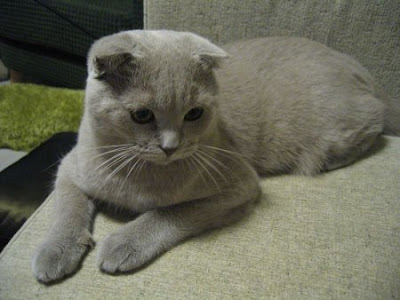In 1961, near the Scottish village of Coupar Angus, a shepherd named William Ross paused to look at a white cat playing in a neighbours yard. The cat had caught the shepherd’s eye because her ears were folded demurely downward. William Ross and his wife Mary were cat fanciers who owned a female seal point Siamese and sold an occasional litter of Siamese kittens. William told Mary about the kitten that he had seen and Mary was intrigued. William visited the neighbours, but they were unable to provide any details about the Scottish Fold Cat origin (her name was Susie) but they promised that if she had any fold-ear kittens of her own the Ross’ could have one.
A year later, Susie took up with the local tom and had a litter of 2 kittens, a male and female. Both kittens developed folded ears. The male was neutered and given to some friends and the Ross’ were given the female. She was white, like her mother and was named Snooks. Three months later Susie was killed on the road by a car. Fortunately Snooks was a good and prolific mother and the Scottish Fold was launched as a Breed. While Snooks began producing kittens, the Ross’ decided to do what they could to promote and perpetuate fold-eared cats, they acquired a white British Shorthair female named Lady Moy to breed to one of Snook’s sons. They registered a cattery name with the Governing Council of the Cat Fancy in Great Britain. They chose Denisla (pronouncedden-eye-la).
The Ross’ eventually contacted Pat Turner, a landowner with an unyielding interest in cat breeding and genetics. Pat, after visiting the Ross’ returned home with a 1-year-old male named Snowdrift who had amber eyes and a short thick tail. Pat produced 76 kittens over 3 years, 42 had folded ears and 34 straight ears. Eventually due to ill health Pat had to stop breeding. She placed some of her Folds with people in England who wanted to work with the breed and 2 Folds were shipped to Neil Todd (a geneticist) in Massachusetts. Todd was studying the effects of the genetic mutations in cats. The first Fold kittens were born in America on the 30th November 1971. Todd placed the cats in the care of Sally Wolfe Peters in Pennsylvania.
Sally founded the International Scottish Fold Association in 1974 with the first Co-President being Mary and William Ross. As a result of this the Scottish Fold became eligible for a Championship competition in the Cat Fanciers Association of America on 1st May 1978. Ironically the Ross’ involvement with the Breed ended by this time. The intransigence of the British Cat Fancy and frustration of seeing 15 years of work go unheralded in Great Britain let the Ross’ to give up these cats. Although the sacrifices of this couple went unappreciated in their own Country, the Ross’ will always be remembered as the Patron Saints of the Scottish Fold in America.
Scottish Fold Character
The Scottish Fold Cat has a character that embraces the very best of temperament from its principle ancestors-the American and British Shorthairs, plus a special something that seems to emanate from the genetic mutation that creates the folded ears. Of course, there is no evidence to prove that themutation has any bearing whatsoever on the character of the Fold. Yet these cats seemingly display a special charm. If you talk with any Scottish Fold owner, they will assure you that this breed is like no other.
Scottish Fold Cat Colours
The Scottish Fold come in a wide range of coat colours and patterns. Current breeding programs have developed over 36 different colours & patterns.
Scottish Fold Cat Temperament
Scottish Folds, once mature, will devote a great deal of time to contemplating the world. They will sit very quietly watching everything going on around them. They see no need to be involved in most things. This would burn up energy better reserved for leaping onto you lap and attention, or moving at high speed when they hear the sound of a tin of cat food being opened.
But they do have their moments and will forget their aloof demeanour at times to become the cheeky little kittens they once were. They will grow out of their mischievous period. This doesn’t make them dull, it means they would rather play for short periods with cat toys rather than invent games, such as climbing up the drapes, knocking ornaments from shelves, or rummaging through drawers that they have learned to open. This sort of behaviour just isn’t Scottish Fold.

















0 comments:
Post a Comment